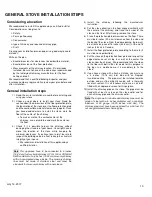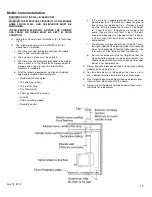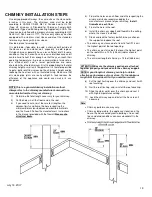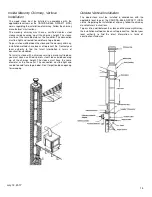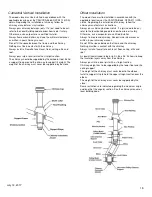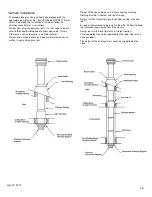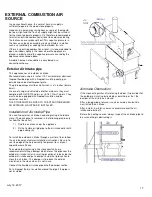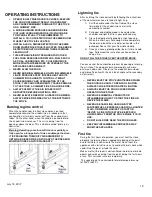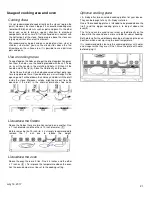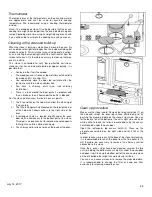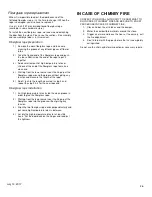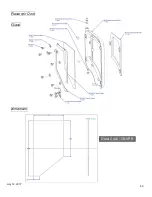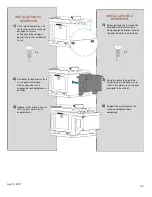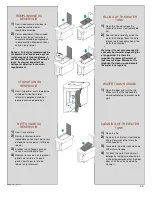
July 13, 2017
24
MAINTENANCE
Ash Removal
Wood burning doesn’t usually completely transform wood into
combustion gas. The leftover residues are called ashes and
they must be removed from the combustion chamber to help
oxygen circulation.
The ashes have to be removed periodically up to every 2 or 3
days during intensive burning period. Never leave excessive
accumulation in the combustion chamber because it can
reduce the firebox volume and prevent the air supply from
reaching the logs. As a result, this can affect considerably the
performance of your stove.
Remove ashes excess when it gets 3 to 4 inches deep in your
firebox. Note that the fire must have been put out and the stove
must be cool enough for cleaning. You can leave an ash bed
approximately 1 inch deep at the bottom of the firebox to help
maintain a hot charcoal bed.
The best time to remove ashes is after a long heating period
like in the morning when the stove is relatively cold enough to
manipulate ashes and the chimney is still hot. The hot chimney
draft will then vacuum the dust inside the stove.
To clean ashes from the combustion chamber, you must have
the following tools.
•
Ash shovel;
•
Ash brush;
•
A metal bucket with an airtight lid or other container
made for this purpose.
Some embers are mixed with ashes and they could still catch
fire in a few minutes or a few days. It is very important that the
metal lid is airtight. The bucket must be put on a non-
combustible tile or brick.
Ash Disposal
Some embers can still catch fire long after the fire is deemed
quenched. If embers have enough oxygen, they can stay lit for
minuts or even for a few days.
It’s mandatory to store ashes:
•
In a metal container with an airtight metal lid and
firmly closed;
•
Outside the house on a non-combustible material
such as gravels, concrete and bricks;
•
Far enough from any combustible material;
•
Far enough from any inflammable liquid and vapor.
Before the ashes are discarded or buried in the soil, they
should be retained in a closed container until they get
thoroughly cooled and completely extinguished.
NEVER PUT TRASHES IN THE ASH CONTAINER.
Creosote Formation
When wood is incompletely burned, it produces tar and other
organic vapors, which condensate as creosote. The creosote
vapor condenses on the relatively cold flue walls. As a result,
creosote residue accumulates on the flue lining. The creosote
could be in forms of tarry liquid, dust, soot or crystallized
deposit. This creosote makes an extremely hot fire when
ignited and it is the principal cause of chimney fire.
The chimney pipe and chimney should be inspected at least
once a week during the first several months to determine the
sweeping frequency
Contact your local fire authority to know how to handle a
chimney fire.
Chimney Inspection
Wood moisture, wood type, combustion quality are some
factors that can influence the creosote buildup speed in the
chimney pipes.
The chimney and the chimney pipes must be inspected at least
once every two months during the heating season. You can
contact a chimney sweeper to evaluate the sweeping
frequency required. You can sweep the chimney yourself. To
do so, extinguish the wood stove and wait until it cools down.
Thereafter, remove the chimney collar screws and the stove
collar screws to inspect the chimney pipe. Look inside the
chimney with a flashlight. For a masonry chimney, it is possible
to inspect inside the flue by removing at first the bottom steel
flue plug. Afterward, you should be able to insert a small mirror
in the chimney lookout to conduct your inspection. Don’t forget
to put back the flue plug. For an outdoor factory built chimney,
open the chimney cap at the bottom of the chimney. It is better
to do an inspection during the daytime during a sunny day.
If there is a creosote buildup of 1/8 inch (3 mm) or more , if the
chimney diameter appears smaller and/or if you cannot see the
chimney cap, It’s a sign of an important creosote accumulation
which will require a chimney sweeping.
Chimney Sweeping
Chimney sweeping needs special tools such as fiberglass rod
and a chimney brush of proper diameter.
In order to sweep the chimney, you will need to climb on the
roof top to remove the chimney cap. If the chimney is taller
then 5 feet above the roof it might be necessary to remove a
chimney section.
If you are not comfortable doing it, we recommend calling a
professional chimney sweeper certified by the APC in Quebec,
the WETT in the rest of Canada or by the NFI in the United
States.

